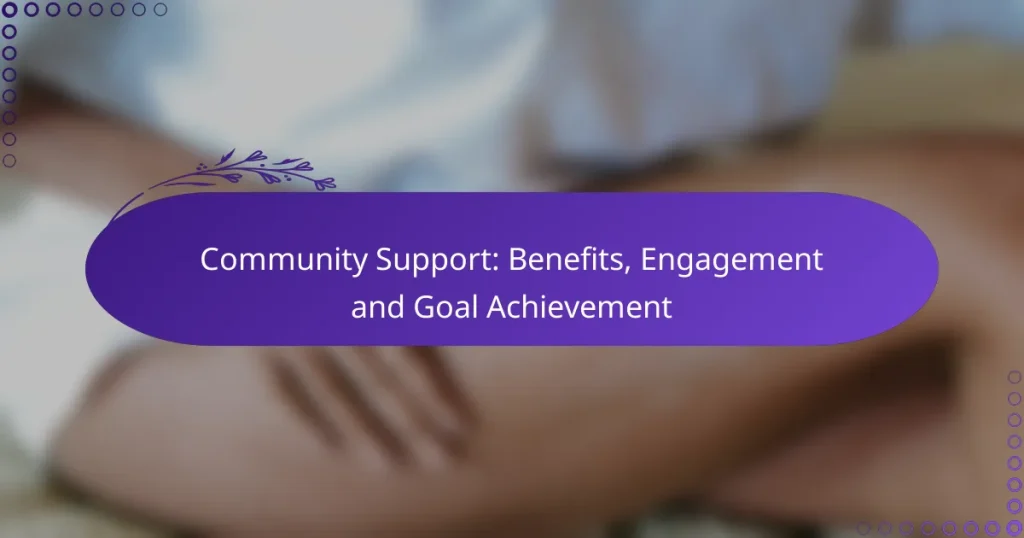Community support plays a crucial role in achieving personal and professional goals by offering encouragement, resources, and valuable connections. Engaging with a supportive network fosters accountability and a shared sense of purpose, ultimately enhancing individual success. Additionally, active community involvement promotes well-being, skill development, and meaningful relationships, making it an essential aspect of personal growth.
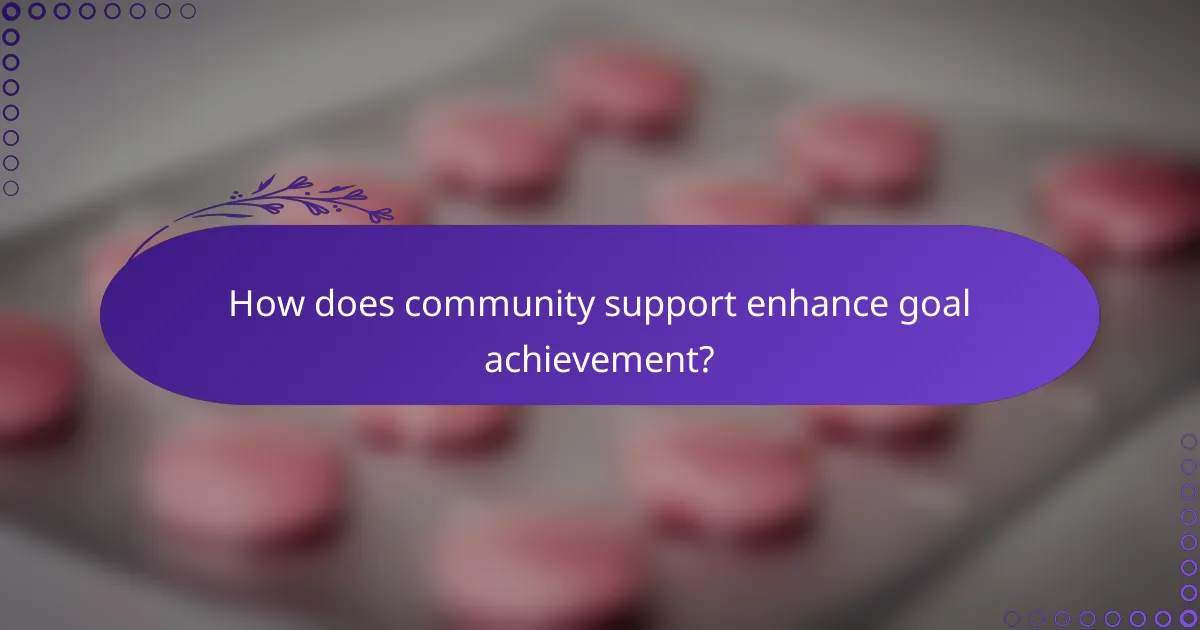
How does community support enhance goal achievement?
Community support significantly enhances goal achievement by providing encouragement, resources, and connections that individuals might lack when pursuing their objectives alone. Engaging with a supportive community fosters a sense of accountability and shared purpose, which can lead to greater success in reaching personal and professional goals.
Increased motivation
Being part of a community can greatly boost motivation levels. When individuals share their goals and progress with others, they often feel more compelled to stay committed and push through challenges. The encouragement from peers can create a positive feedback loop, where successes are celebrated, and setbacks are met with support.
To harness this motivation, consider setting up regular check-ins or group meetings where members can share updates and celebrate milestones. This practice not only reinforces individual commitment but also strengthens community bonds.
Access to resources
Community support provides access to a wealth of resources that can aid in achieving goals. This may include knowledge sharing, mentorship, and even financial assistance in some cases. Communities often have members with diverse skills and experiences, allowing for collaborative problem-solving and resource pooling.
For instance, if someone is starting a small business, their community might offer advice on marketing strategies, access to local funding opportunities, or connections to potential clients. Engaging actively with the community can help uncover these valuable resources.
Networking opportunities
Networking within a community can open doors to new opportunities that are essential for goal achievement. By connecting with others, individuals can find collaborators, mentors, or even job leads that align with their aspirations. These relationships can lead to partnerships that enhance both personal and professional growth.
To maximize networking benefits, attend community events, workshops, or online forums where members can interact. Building genuine relationships can lead to unexpected opportunities and support that can propel individuals toward their goals.
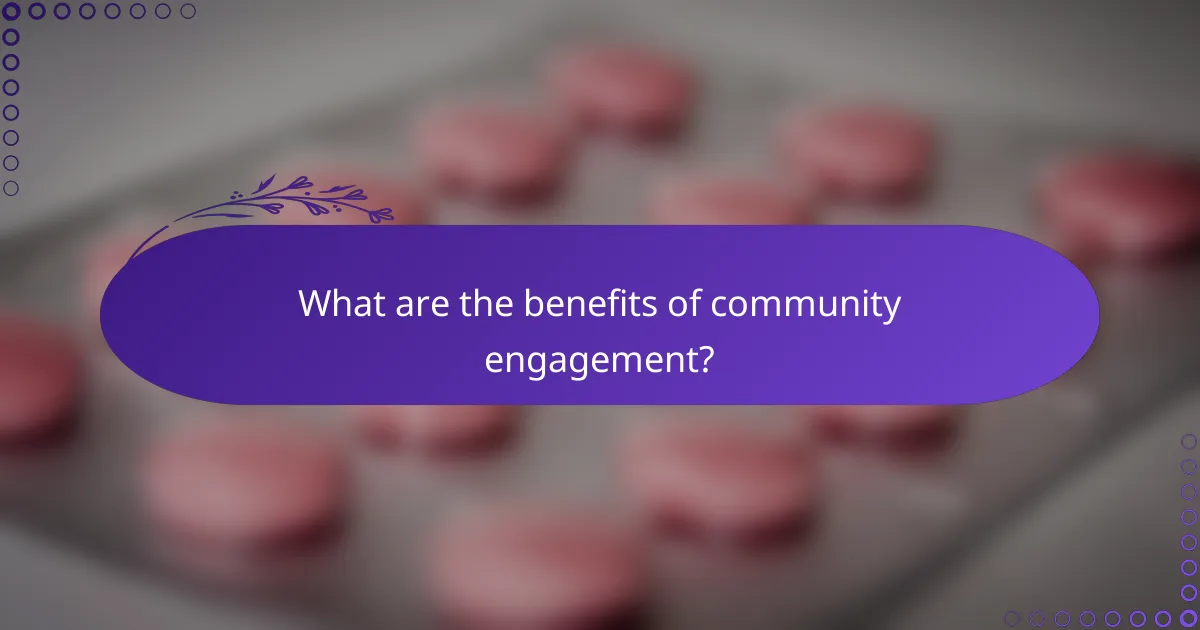
What are the benefits of community engagement?
Community engagement offers numerous benefits, including enhanced well-being, skill enhancement, and the formation of meaningful connections. These advantages contribute to personal growth and collective success, making community involvement a valuable endeavor.
Improved mental health
Engaging with a community can significantly boost mental health by providing social support and reducing feelings of isolation. Regular interaction with others fosters a sense of belonging, which is crucial for emotional well-being.
Participating in community activities can also lead to reduced stress levels and lower rates of anxiety and depression. For instance, volunteering or joining local groups can create a positive feedback loop that enhances mood and overall mental resilience.
Skill development
Community engagement is an excellent avenue for acquiring new skills and enhancing existing ones. Through participation in workshops, events, or collaborative projects, individuals can learn valuable competencies such as leadership, communication, and teamwork.
For example, joining a local sports team or a community arts group can provide practical experience that translates into personal and professional growth. This hands-on learning often occurs in a supportive environment, encouraging experimentation and creativity.
Stronger relationships
Building relationships within a community can lead to deeper connections and a stronger support network. Engaging with others fosters trust and mutual understanding, which are essential for lasting friendships.
Moreover, these relationships can provide practical benefits, such as networking opportunities and collaboration on common goals. For instance, local business groups often facilitate partnerships that can enhance career prospects and community initiatives.
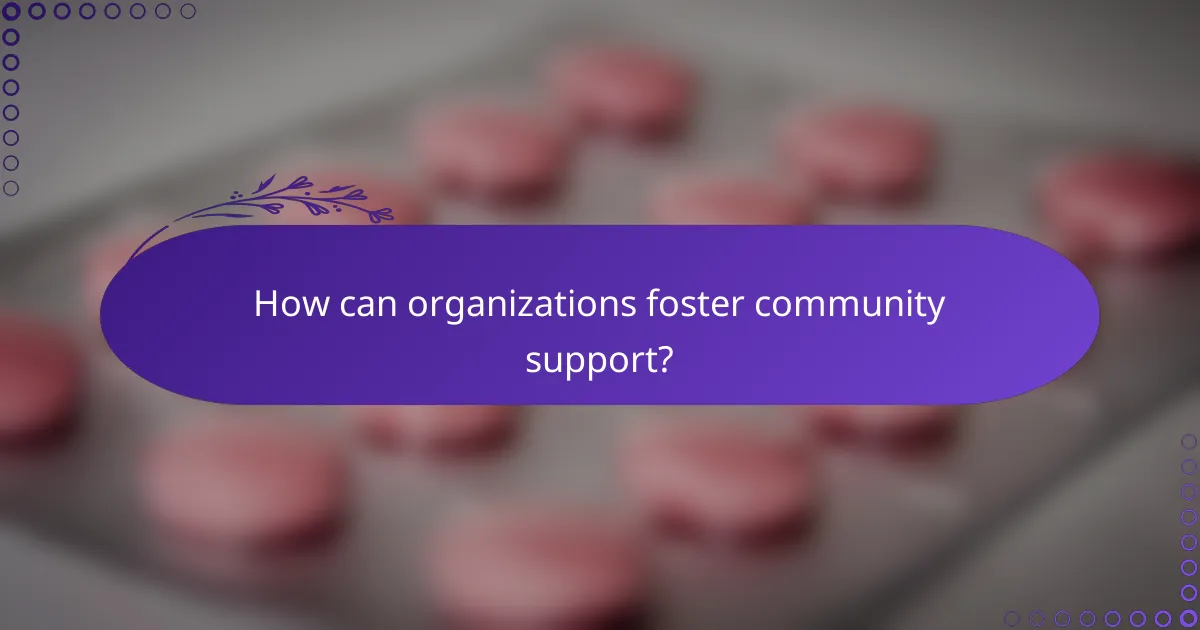
How can organizations foster community support?
Organizations can foster community support by actively engaging their members, creating inclusive spaces, and providing resources that empower individuals. This approach not only strengthens relationships but also enhances overall goal achievement.
Creating inclusive environments
Inclusive environments are essential for fostering community support, as they encourage participation from diverse groups. Organizations should focus on accessibility, ensuring that facilities and resources are available to everyone, regardless of their background or abilities.
To create an inclusive atmosphere, consider implementing policies that promote diversity and respect. Regularly solicit feedback from community members to identify areas for improvement and adapt practices accordingly.
Offering training programs
Training programs can significantly enhance community support by equipping individuals with the skills needed to engage effectively. Organizations should offer workshops or seminars that address relevant topics, such as conflict resolution, communication skills, and leadership development.
These programs can be tailored to different skill levels and interests, ensuring that all community members find value. Providing certifications or recognition for completed training can further motivate participation and commitment.
Utilizing social media platforms
Social media platforms are powerful tools for fostering community support, as they facilitate communication and connection among members. Organizations should establish a strong online presence to share updates, resources, and success stories that resonate with their audience.
Engagement strategies may include hosting live Q&A sessions, creating discussion groups, or sharing user-generated content. Regular interaction on these platforms can help build a sense of belonging and encourage active participation in community initiatives.
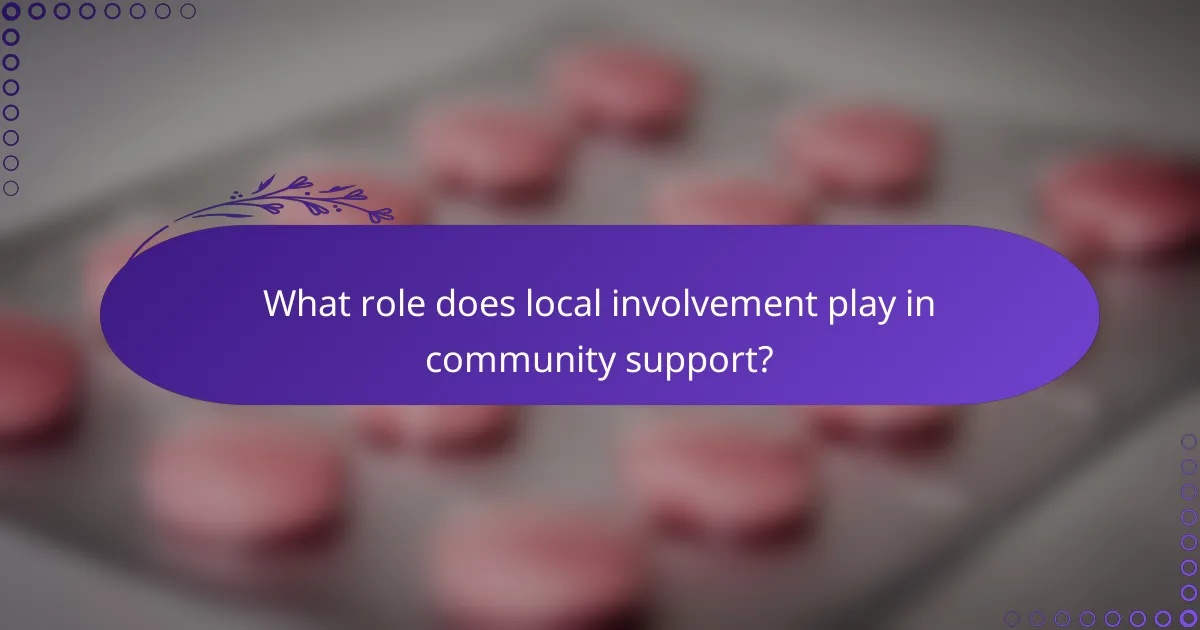
What role does local involvement play in community support?
Local involvement is crucial for effective community support as it fosters connections among residents, enhances resource sharing, and drives collective action. Engaging local individuals and organizations creates a sense of ownership and responsibility, leading to more sustainable outcomes.
Building trust within communities
Trust is the foundation of any strong community. When individuals participate in local initiatives, they develop relationships that enhance mutual understanding and cooperation. Regular interactions through community events or volunteer opportunities can significantly strengthen these bonds.
To build trust, focus on transparency and open communication. Share information about community projects and encourage feedback to ensure everyone feels heard. This approach not only fosters trust but also encourages more residents to get involved.
Encouraging local partnerships
Local partnerships are essential for maximizing resources and expertise within a community. Collaborating with local businesses, schools, and non-profits can lead to innovative solutions for community challenges. For example, a partnership between a local food bank and grocery stores can help reduce food waste while supporting those in need.
To encourage partnerships, identify common goals and interests among potential collaborators. Organizing joint events or initiatives can help establish these connections. Additionally, consider creating a directory of local organizations to facilitate networking and resource sharing.
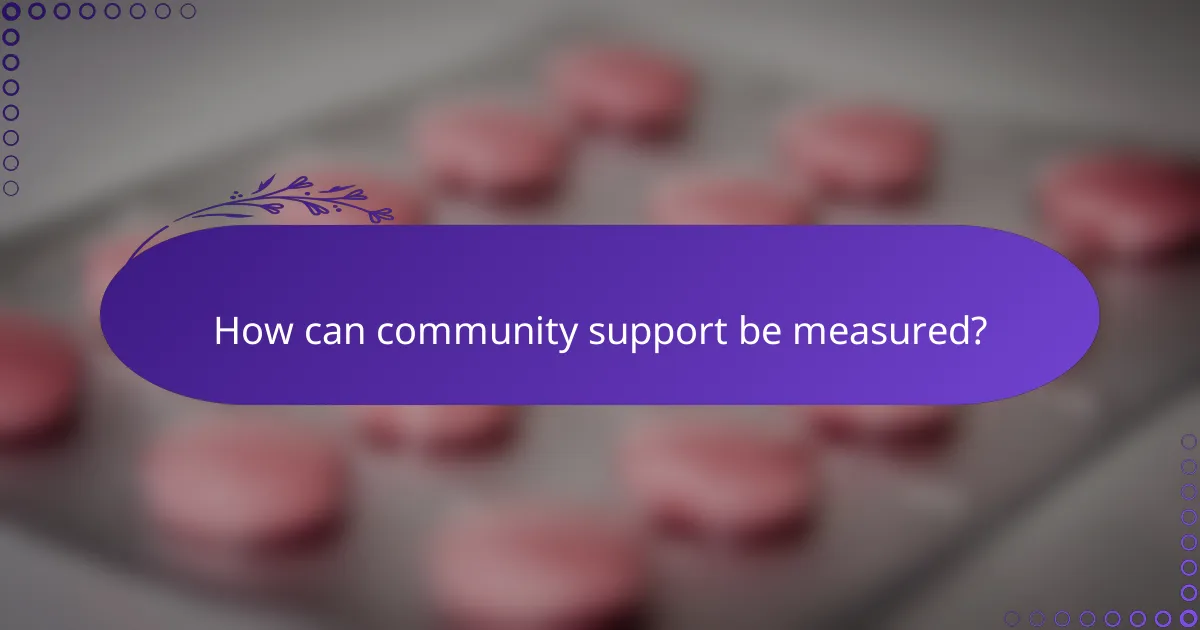
How can community support be measured?
Community support can be measured through various methods that assess engagement, satisfaction, and participation. Effective measurement often involves collecting data from community members to gauge their experiences and involvement.
Surveys and feedback
Surveys are a direct way to gather feedback from community members about their experiences and perceptions of support. They can include questions about satisfaction levels, perceived benefits, and suggestions for improvement.
To ensure effective surveys, keep questions clear and concise, and consider using a mix of multiple-choice and open-ended questions. Aim for a response rate of at least 20-30% to obtain meaningful insights.
Participation rates
Participation rates reflect the level of engagement within a community, indicating how many members are actively involved in activities or initiatives. Tracking attendance at events, volunteer hours, or contributions to projects can provide valuable data.
To analyze participation effectively, compare current rates to historical data or set benchmarks based on similar communities. A steady increase in participation can signal growing support, while a decline may require further investigation and outreach efforts.
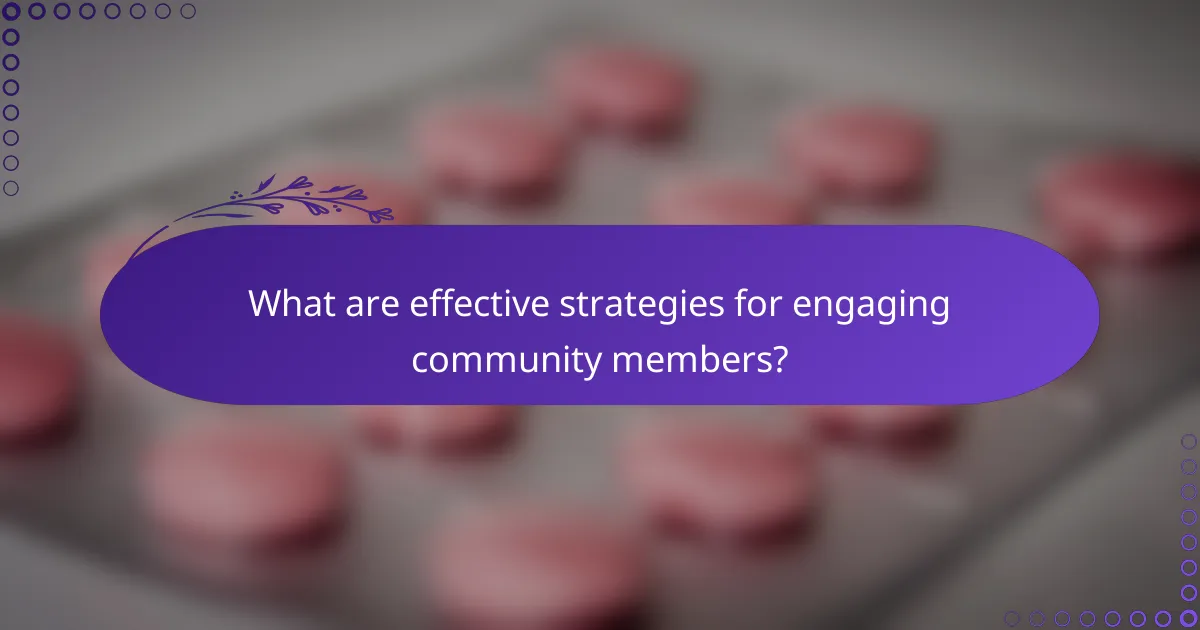
What are effective strategies for engaging community members?
Effective strategies for engaging community members include organizing events, utilizing social media, and fostering open communication. These methods help build relationships, encourage participation, and create a sense of belonging among members.
Organizing events
Organizing events is a powerful way to engage community members and foster connections. These can range from casual meetups to formal workshops or festivals, depending on the community’s interests and goals.
When planning events, consider the preferences and schedules of your members. Aim for a mix of activities that cater to different interests, such as educational sessions, social gatherings, or volunteer opportunities. For example, hosting a monthly potluck can encourage participation while allowing members to share their culinary skills.
To maximize attendance, promote events through various channels, including social media, newsletters, and community boards. Ensure to follow up with participants afterward to gather feedback and strengthen relationships. Avoid scheduling conflicts with major local events to increase turnout.
